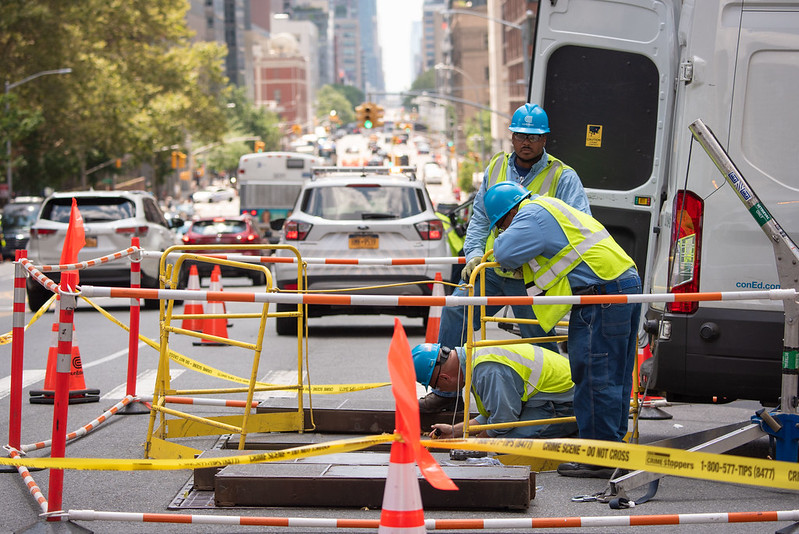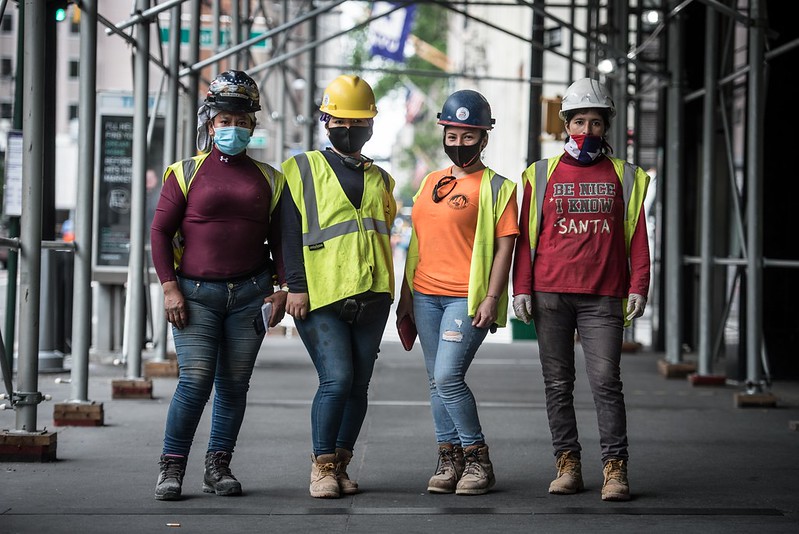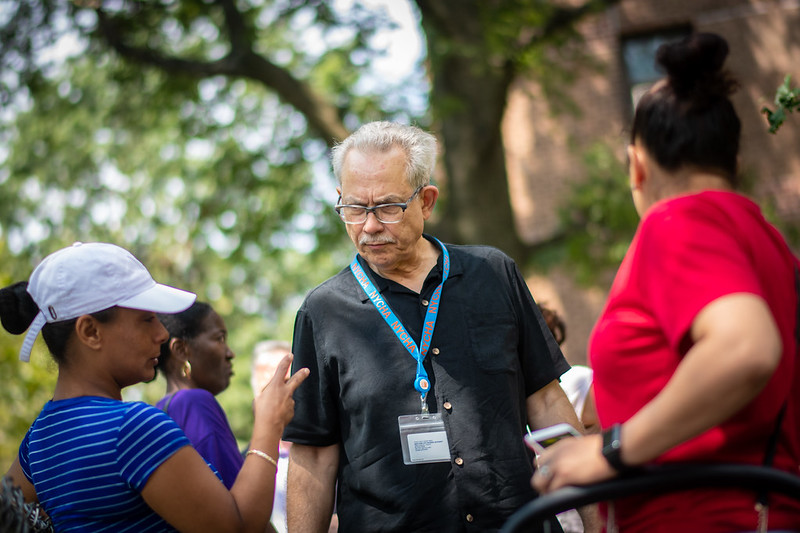Rebuilding Smarter After Hurricane Isaias Devastated New York City’s Utility Infrastructure

Repairing vital infrastructure (photo: Michael Appleton/Mayor's Office)
Despite a $3.5 billion investment to protect New York City from a repeat of the Hurricane Sandy disaster, Hurricane Isaias just revealed we remain deeply vulnerable to infrastructure failure. In terms of power outages, Isaias was the second most destructive storm in New York’s history, knocking out power to 267,000 people in New York City and Westchester County. Weeks later, many are still waiting for the lights to come back on.
We’re barreling towards another man-made disaster ahead of what is anticipated to be a severe hurricane season and the public health crisis caused by a COVID-19 pandemic. The management and physical state of our utility infrastructure is needlessly exacerbating our situation.
It’s essential that we recognize that the problems we face stem primarily from poor workforce management. And it’s time to do something about it.
Utility infrastructure is similar to a car, in that preventive maintenance is paramount to a well-functioning system. Unfortunately, the skeletal workforce that’s been pared back after years of attrition means that utilities routinely defer system maintenance, leaving the grid more vulnerable to widespread outages from extreme weather events.
Around the time Hurricane Sandy struck in 2012, roughly 8,000 men and women worked at Con Edison in New York City. Today, that number is below 7,000, which means utilities like Con Edison are increasingly turning to systems of ‘mutual aid’ – often contracting with far-flung utilities for assistance. Typically, crews from neighboring states take on the bulk of ordinary storm cleanup without much trouble. In the aftermath of Hurricane Isaias, however, mutual aid crews were traveling from as far as Tennessee to restore power, which severely delayed the restoration of service to many customers.
It’s time we strengthen our energy grid and mitigate the threats of future disasters by investing in our utility workforce. As the widespread damage and suffering from Isaias shows, we simply cannot afford to take a reactive approach. We need to start making the necessary preparations for the next storm now.
Reinvigorating the utilities workforce would also be a much-needed stimulus to New York’s battered economy, helping to put people back to work. Given the deep budget holes currently faced by state and city governments, we could explore the possibility of a public-private partnership model to fund the necessary training and hiring. It’s a model that would make the investment go twice as far, boosting job-creation and economic growth. The Center for an Urban Future estimates New York City’s overall infrastructure requires a $47.3 billion investment over five years.
These investments must be coupled with a strong commitment to equity — especially in light of the broad disparities exposed by the COVID-19 pandemic. We must do more to make sure the utility workforce reflects the rich diversity of our city’s population. Utility sector jobs are well-paid positions that offer a path to a better life, and they should be open to all New Yorkers.
Boosting the workforce to properly manage the grid along with a concerted effort to diversify recruitment are the type of forward-thinking steps we need right now. They must be complemented by greater resiliency efforts from Con Edison and other utilities. It’s clear the current level of investment has been insufficient. One idea that should be revisited is burying overhead power lines, which are largely concentrated in the outer boroughs and are more likely to suffer storm-related damage.
The coming challenges of the 21st century demand infrastructure that is resilient, modern, and properly maintained. That requires a workforce — and a government — that is ready to roll up its sleeves and get to work strengthening our grid right away. We cannot allow preventable disasters to wreak havoc on our energy system, which fall disproportionately on minority and low-income populations. As New Yorkers, let us rise to the challenge of building our city back, better than ever.
***
Eric Adams is Brooklyn Borough President. James Slevin is President of the Utility Workers Union of America, AFL-CIO, representing 50,000 active members employed in the energy, electric, gas, steam, water, and related professional, technical, and service industries. On Twitter @BKBoroHall & @The_UWUA.
***
Have an op-ed idea or submission for Gotham Gazette? Email This email address is being protected from spambots. You need JavaScript enabled to view it.
New Reason Not to Fall for Trump's Immigrant Labor Threat Narrative

Construction workers, New York (photo: Michael Appleton/Mayor's Office)
Among the many conversations I’ve had about the upcoming election, one stands out in my mind. It was with an old friend who is riding out the pandemic in upstate New York. She told me about an acquaintance of hers there, a white male construction worker, who is a steadfast Trump supporter. She could not understand why, given that he is struggling economically, he finds the ‘MAGA’ narrative so appealing. “What he is really angry about is all those Mexicans and Guatemalans around here who are taking jobs away from people like him,” she reported.
There’s no danger that New York State will land in the Trump column in November, and lately immigration has faded from the headlines, displaced by the Black Lives Matter protests and Trump’s demonizing of “rioters” and “looters” in the streets. This time around “law and order” is the focus of Trump’s presidential campaign. But we should not lose sight of the immigrant scapegoating that was his North Star in 2016. It remains a potent force for a sizable chunk of Trump’s base, especially white working-class Americans like that construction worker.
This Labor Day brings another reminder of the reversal of fortune that the nation’s white working class has endured over recent decades, as de-unionization and labor market restructuring drove economic inequality to sky-high levels not seen for over a century. Employment insecurity and precarity, already widespread before 2019, have been deepened by the COVID-19 pandemic. Trump and his allies continue to trumpet the immigrant threat narrative, blaming immigrants for “taking American jobs” and for the collapse in living standards that so many U.S.-born white workers have experienced. But this narrative – like so many others promoted by the president – has no grounding in reality.
As I document in detail in a new book, the immigrant threat narrative confuses cause with consequence. In industry after industry – including construction – the degradation of wages and working conditions preceded the influx of immigrants.
Starting in the 1970s, employers moved to undercut or eliminate unions, and turned formerly well-paid jobs with health and pension benefits into low-wage jobs with few appealing features. In the same period, business-promoted deregulation and skyrocketing subcontracting further contributed to the mushrooming of low-wage, precarious work. In response, U.S.-born workers increasingly abandoned or rejected newly degraded jobs, if they had the option. Only then did employers recruit immigrant workers to fill the resulting vacancies. In short, it was labor degradation that led to low-wage immigrant employment, not the other way around.
Pitting immigrants against their U.S.-born co-workers is just one of many examples of Trump’s divisive rhetoric. Both groups have suffered from employers’ intransigent anti-unionism and from neoliberal policies driving labor degradation, and both groups would benefit from working together to challenge those policies. One arena in which they can do so is the labor movement.
U.S. unionism is at a historic ebb in numbers and power, but immigrants – especially those who arrived in the U.S. many years ago – have a unionization rate only slightly lower than that of U.S.-born workers. In New York, one of the few regions of the U.S. where organized labor remains relatively strong, with union density roughly double the national average, foreign-born workers actually have a slightly higher unionization rate (21%) than their U.S.-born counterparts (20%), as Stephanie Luce and I document in a new report analyzing 2019-20 data.
It turns out that immigrants, the vast majority of whom came to this country in search of economic opportunity, are disproportionately eager to become union members if the opportunity arises. Although recent immigrants – especially the undocumented – often face obstacles in gaining access to unionized jobs, though that changes once they get their bearings in the labor market, and changes even more if they become U.S. citizens. The unionization rate for New York City immigrants who are naturalized citizens is a whopping 28%. In the nation as a whole the rate is 12%, slightly higher than the 11% unionization rate for U.S.-born workers nationwide.
In recent months, the city has hailed its “essential workers” – another disproportionately foreign-born group. The loud recognition of their work at 7 p.m. in the evening no longer marks the end of each day, but on Labor Day, let’s once again remember their role in keeping so many New Yorkers alive, and also challenge the immigrant threat narrative promoted by Trump and his allies. White working-class Americans have every reason to be enraged about their declining living standards, but the target of their anger should be employers and the neoliberal public policies they promote, not immigrants.
***
Ruth Milkman is Distinguished Professor of Sociology at the CUNY School of Labor and Urban Studies and the CUNY Graduate Center, and the author of Immigrant Labor and the New Precariat.
***
Have an op-ed idea or submission for Gotham Gazette? Email This email address is being protected from spambots. You need JavaScript enabled to view it.
New Yorkers Should Back NYCHA’s New Blueprint for Change

NYCHA Chair Greg Russ (photo: Michael Appleton/Mayoral Photography Office)
With so much attention focused on the COVID-19 catastrophe and the 2020 elections, our leaders and the media have all but overlooked the importance of a plan to improve the lives of 300,000 low-income and working-class New Yorkers, many of them people of color. The plan merits support from all of New York’s elected officials.
New York City Housing Authority (NYCHA) Chair Gregory Russ has produced an innovative “Blueprint for Change.” In conjunction with other programs now underway, it promises to restore all of NYCHA to a state of good repair, and simultaneously to put the single most important source of affordable housing for limited income New Yorkers on a viable financial path for the long-term.
It is the first time in decades that anyone has offered a serious plan to fix and maintain NYCHA rather than partial measures and stop-gap solutions. It offers a bold mechanism for filling an intimidating $25 billion gap in an even more daunting $40 billion capital plan to fix “leaky roofs and exteriors, mold, faulty and unreliable heating systems, broken elevators, poor or nonexistent site lighting” and other problems plaguing 2,413 NYCHA properties, according to a 2018 physical needs assessment.
The plan is right for the times. NYCHA’s Blueprint for Change will anchor the city’s desperate need for affordable housing while providing thousands of good union construction and maintenance jobs to support post-covid recovery. It will include apprenticeship programs for unemployed and underemployed NYCHA residents that have been sorely lacking for years. Energy efficiency will be upgraded, reducing operating expenses while contributing to New York’s Green New Deal, and in response to covid-heightened awareness of healthcare injustice, it can include creation of medical clinics within NYCHA developments.
Unlike some other NYCHA repair proposals tenants have not trusted, this one keeps control of New York’s public housing assets with a public entity. At its heart is creation of a Public Housing Preservation Trust to receive federal funds through a program that issues Tenant Protection Vouchers. The voucher program includes many arcane details, but essentially is designed to provide market levels of rent to eligible tenants. Those amounts are far higher than NYCHA receives now based on a cap of 30 percent of tenant income.
The purpose of Tenant Protection Vouchers is to allow people living in unacceptable public housing to afford to transition to homes that meet housing standards. NYCHA believes all 110,000 of its units not covered by other improvement plans are eligible.
The Blueprint has an important twist. NYCHA intends to pool the voucher funds received and to use the stable income stream created to support bond issues. The capital raised—six times the annual voucher revenue—will fund NYCHA’s capital improvements. In effect, the plan repurposes an existing federal program to protect individual tenants into a means of protecting 300,000.
The plan requires cooperation by the city, state, and federal governments, never an easy feat. But the city has a compelling obligation to improve the condition of NYCHA’s buildings. The state too has reason to act, and with Democrats in control of the State Legislature and the governor’s office, the politics in Albany are well-aligned.
It is hard to imagine the Trump administration favoring a plan to help poor New Yorkers of color. Yet, NYCHA’s historic ineptitude led to appointment of a federal monitor in 2019 to ensure compliance with Department of Housing and Urban Development rules. Continued failure could force the federal government to take responsibility for NYCHA, something it does not want to do.
Moreover, at the moment, polls favor Democrats to win the White House this November, and the party is running a spirited campaign to recapture the U.S. Senate. It seems sure to hold onto the House of Representatives, so favorable federal treatment for the NYCHA Blueprint may soon become likely.
The biggest city in the greatest state in the richest country in the world has a moral obligation to produce adequate housing for every one of its residents—and where the housing market falls short, the government needs to step in.
New York’s political class is understandably focused on elections at the moment. But the day after ballots are cast, no matter what the outcome, every elected official in New York should begin searching for a way to convert NYCHA Chair Russ’ Blueprint into an active project. The well-being of 300,000 long-suffering New Yorkers depends on it.
***
Chris McNickle writes about New York government and politics. He is author of Bloomberg: A Billionaire’s Ambition. On Twitter @NYChrisMcNickle.
***
Have an op-ed idea or submission for Gotham Gazette? Email This email address is being protected from spambots. You need JavaScript enabled to view it.




